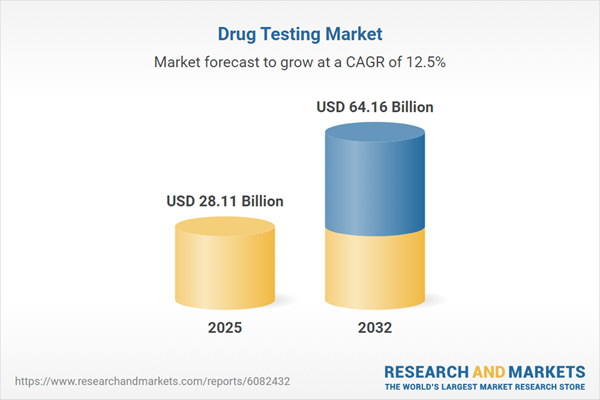Speak directly to the analyst to clarify any post sales queries you may have.
The global drug testing market is experiencing dynamic evolution, shaped by regulatory advances, evolving substance patterns, and rapid technological progress. Senior executives are responding with strategies designed to address compliance, agility, and public safety in today’s environment.
Market Snapshot: Drug Testing Market Size and Growth Trajectory
The drug testing market expanded from USD 24.94 billion in 2024 to USD 28.11 billion in 2025 and is projected to reach USD 64.16 billion by 2032, driven by a CAGR of 12.53%. This growth reflects increased regulatory pressure, the need for preventative workplace and public safety measures, and the introduction of advanced analytical instruments enabling higher throughput and precision. Organizations across healthcare, government, and commercial sectors are seeking adaptable testing solutions to address a broadening set of compliance challenges and improve operational excellence.
Scope & Segmentation: Coverage by Technology, Application, and Region
- Sample Types: Blood (including plasma and serum), hair (body and scalp), oral fluid (stimulated and unstimulated), sweat, and urine (24-hour and spot urine), each revealing different patterns of substance use to inform precise testing protocols.
- Technologies: Chromatography (gas and liquid), immunoassays (ELISA and point-of-care), mass spectrometry (MALDI and tandem MS), and spectroscopy (FTIR and UV spectroscopy) constitute the technological backbone for screening, detection, and confirmation in varied environments.
- Test Types: Health screening, post-incident analysis, pre-employment checks, random drug and alcohol monitoring, and ongoing rehabilitation follow-up are core applications supporting safety and compliance.
- End Users: Clinics, hospitals, rehabilitation centers, commercial laboratories (clinical and reference), and forensic laboratories (both government and private) require specialized solutions for their unique operational needs.
- Regions: The market covers the Americas (North and Latin America), Europe, the Middle East, Africa, and Asia-Pacific, each with distinct healthcare systems, regulatory practices, and growth opportunities.
- Companies Analyzed: Quest Diagnostics Incorporated, Thermo Fisher Scientific Inc., F. Hoffmann-La Roche Ltd, Danaher Corporation, Abbott Laboratories, Siemens Healthineers AG, Bio-Rad Laboratories, Inc., PerkinElmer, Inc., and Sysmex Corporation are driving competition and innovation.
Key Takeaways for Strategic Decision-Makers
- Organizations are upgrading analytical platforms and quality controls to address the complexities introduced by synthetic drugs and novel psychoactive substances, making ongoing investment in testing technology essential for risk mitigation.
- Advanced mass spectrometry and portable devices are expanding drug testing capabilities outside traditional laboratories, supporting faster decision-making and enabling decentralized screening programs.
- Shifts in global regulatory policy are elevating standards for laboratory accreditation, impacting both commercial and institutional drug testing operations worldwide.
- Flexibility in workflow design is crucial due to diverse sample types and end-user requirements, leading to demand for customized, scalable solutions that maintain analytical accuracy and operational efficiency.
- Industry alliances, focused R&D, and digital integration with laboratory information management and cloud platforms are fostering more streamlined, integrated testing systems that improve both compliance and productivity.
Impact of United States Tariffs on Market Supply Chains
Recent U.S. tariffs on analytical instruments and laboratory consumables have introduced new operational cost pressures for drug testing laboratories. This has led many organizations to seek domestic manufacturing partnerships, reevaluate supplier relationships, and emphasize procurement strategies like bulk consolidation and alternative sourcing. These shifts are enhancing supply chain resilience while driving a gradual increase in regional production capabilities across the drug testing sector.
Methodology & Data Sources
This report utilizes a blend of primary and secondary research methods, including executive interviews, insights from laboratory directors, and input from technical specialists. The analysis is grounded in a systematic review of scientific publications, regulatory filings, and industry financial documents, supported by advanced data collection and statistical evaluation to ensure transparency and credibility.
Why This Report Matters
- Delivers a comprehensive market analysis to support strategic planning, capital allocation, and risk management for organizations operating in drug testing services.
- Provides actionable insights for operational efficiency, including supply chain optimization, quality assurance, and cost control under emerging economic and regulatory conditions.
- Equips leaders with up-to-date competitive intelligence and practical recommendations for adopting new technologies, forming effective partnerships, and maximizing future business outcomes.
Conclusion
The drug testing market is transforming in response to evolving regulations, advances in analytical approaches, and expanding use cases. Agility in both strategy and investment remains critical as stakeholders seek integrated, future-ready testing capabilities in an increasingly complex environment.
Table of Contents
3. Executive Summary
4. Market Overview
7. Cumulative Impact of Artificial Intelligence 2025
Companies Mentioned
The companies profiled in this Drug Testing market report include:- Quest Diagnostics Incorporated
- Thermo Fisher Scientific Inc.
- F. Hoffmann-La Roche Ltd
- Danaher Corporation
- Abbott Laboratories
- Siemens Healthineers AG
- Bio-Rad Laboratories, Inc.
- PerkinElmer, Inc.
- Sysmex Corporation
Table Information
| Report Attribute | Details |
|---|---|
| No. of Pages | 197 |
| Published | October 2025 |
| Forecast Period | 2025 - 2032 |
| Estimated Market Value ( USD | $ 28.11 Billion |
| Forecasted Market Value ( USD | $ 64.16 Billion |
| Compound Annual Growth Rate | 12.5% |
| Regions Covered | Global |
| No. of Companies Mentioned | 10 |









